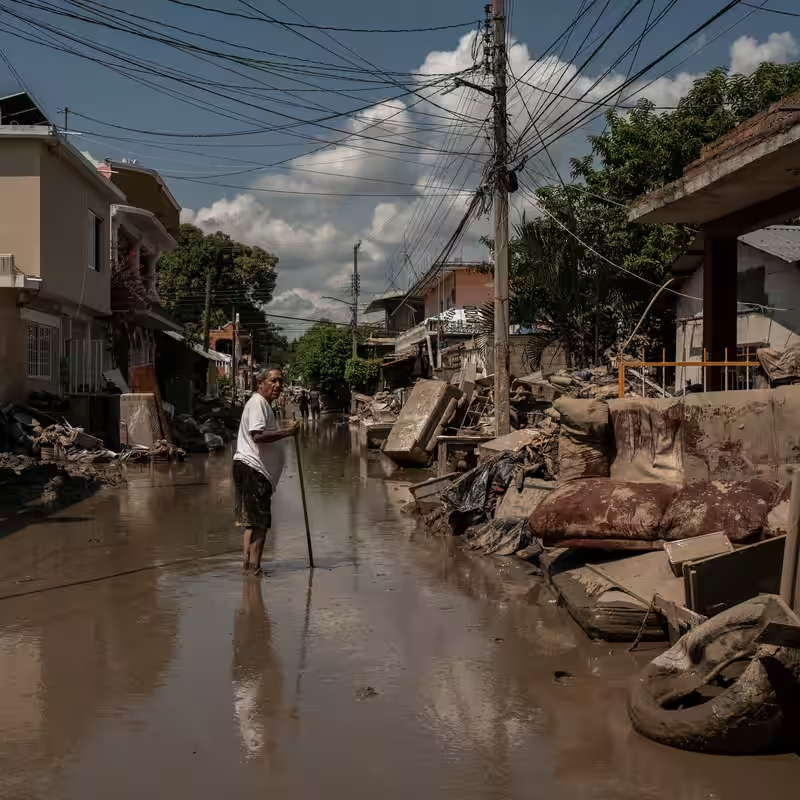Table of Contents
- Crisis Unfolds: Record Rainfall Batters Central Mexico
- Sheinbaum’s Response: Aid, Anger, and Accountability
- The Human Toll: Communities Devastated
- Infrastructure and Economic Fallout
- What’s Next for Recovery and Reform?
- Sources
Crisis Unfolds: Record Rainfall Batters Central Mexico
Last week, central and eastern Mexico were hit by an unprecedented deluge of torrential rains, triggering catastrophic flooding and deadly landslides. The states of Veracruz, Hidalgo, Puebla, and Querétaro bore the brunt of the disaster, with rivers bursting their banks and entire neighborhoods submerged under meters of water.
Mexico floods 2025 have quickly become one of the deadliest natural disasters in the country this decade. Initial reports confirm at least 64 lives lost, with dozens more still missing as rescue teams continue to comb through mud-caked towns and collapsed structures .
Sheinbaum’s Response: Aid, Anger, and Accountability
President Claudia Sheinbaum, just months into her historic presidency, has found herself at the center of a national crisis. She has visited several affected zones, overseeing emergency operations and pledging federal support. On October 14, her administration provided a detailed update on relief efforts, emphasizing the deployment of military personnel, food, and medical supplies .
However, not all have welcomed her presence. In multiple towns, residents confronted the president, voicing frustration over delayed aid and what they describe as a lack of early warning. Facing direct criticism, Sheinbaum defended her government’s actions, stating there were “sufficient resources” to manage the emergency . She also claimed that meteorological data did not provide clear signals that could have predicted the scale of the rainfall, a statement that has drawn skepticism from climate experts .
In a move to improve transparency, Sheinbaum unveiled a dedicated government website during her October 17 morning press conference to track aid distribution and report recovery progress .
The Human Toll: Communities Devastated
Beyond the staggering death toll, thousands have been displaced. Makeshift shelters in schools and community centers are overflowing. Families have lost everything—homes, livelihoods, and in many cases, loved ones.
Local volunteers and NGOs have stepped in where government response has been slow, distributing water, blankets, and hot meals. Social media has become a lifeline for many, with citizens sharing real-time updates and coordinating grassroots rescue missions.
Infrastructure and Economic Fallout
The floods have severely damaged roads, bridges, and power lines, cutting off entire communities. Agricultural fields—vital to local economies—have been washed away, raising concerns about food security and long-term economic recovery.
International credit rating agency Fitch recently criticized Mexico’s disaster preparedness, a point Sheinbaum addressed directly in her press briefing . Rebuilding will require billions of pesos and a coordinated national strategy.
What’s Next for Recovery and Reform?
As the waters recede, the focus is shifting from immediate rescue to long-term recovery. Questions are mounting about the adequacy of Mexico’s early warning systems and climate resilience infrastructure. With climate change increasing the frequency of extreme weather events, experts argue that reactive measures are no longer enough.
For President Sheinbaum, the Mexico floods 2025 represent both a humanitarian emergency and a defining political test. How her administration manages the recovery—and learns from this tragedy—will shape her legacy for years to come.
Sources
- The New York Times: Devastating Floods in Mexico Test President Claudia Sheinbaum
- Web search results on Mexico floods October 2025




